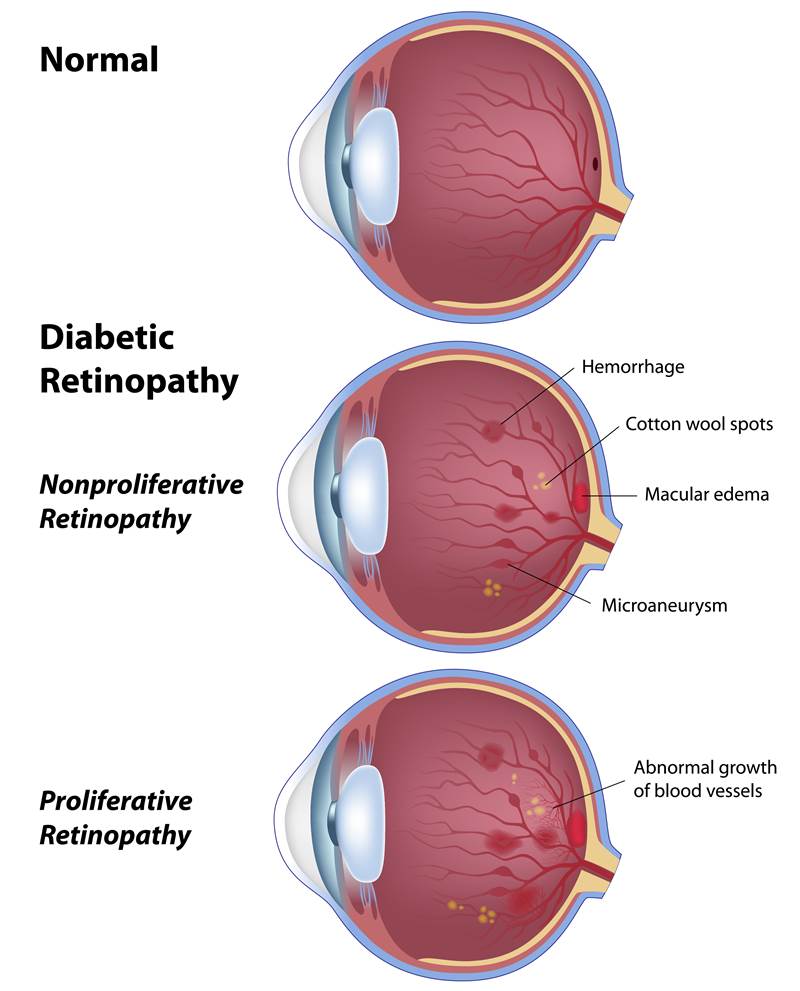Upper Body
Lower Body
General
Sports Related
Diabetic Retinopathy
Knowledge is Power.
True/False - Quiz: Do You Understand Diabetic Retinopathy?
Action Plan - Diabetic Retinopathy
 Diabetic retinopathy (also called diabetic eye disease) is a diabetes-related complication. It damages the blood vessels of the tissue at the back of the retina. There are two types of diabetic retinopathy: early diabetic retinopathy and advanced diabetic retinopathy.
Diabetic retinopathy (also called diabetic eye disease) is a diabetes-related complication. It damages the blood vessels of the tissue at the back of the retina. There are two types of diabetic retinopathy: early diabetic retinopathy and advanced diabetic retinopathy.
Diabetic Retinopathy Diagnosis & Symptoms
Diabetic retinopathy usually affects both eyes, and anyone with type 1 or type 2 diabetes is at risk of developing diabetic retinopathy. The longer you have diabetes, the higher your risk of developing diabetic retinopathy. Diabetic retinopathy can be difficult to diagnose, as it may cause no symptoms or very mild vision problems. It's important to see your ophthalmologist for an eye examination. Supplementary testing might be necessary, which can include a fluorescein angiogram, where dye is injected into your arm and photos are taken of the eye. There is a laser photograph test that can be done to look at the thickness of the retina if your opthalmologist is worried about leakage of fluid into your central vision area.
Diabetic retinopathy symptoms include:
• Blurry vision
• Vision loss
• Floaters
• Difficulty seeing colours
• Dark spots in your vision
Diabetic retinopathy can be caused by poor blood control management. Exc ess sugar in your blood can lead to a blockage of the blood vessels leading to the retina, cutting off the blood supply. While the eye tries to compensate by growing new blood vessels, they don’t properly develop and may begin to leak.
ess sugar in your blood can lead to a blockage of the blood vessels leading to the retina, cutting off the blood supply. While the eye tries to compensate by growing new blood vessels, they don’t properly develop and may begin to leak.
Diabetic Retinopathy Treatment
If you can manage your blood sugars and A1C levels, keep your blood pressure low and controlled and manage your serum cholesterol levels, your risk of developing diabetic retinopathy will be significantly reduced. The treatment of diabetic retinopathy is based on what type of retinopathy you have. Diabetic retinopathy treatment includes anti-VEGF medication, steroid injections, vitrectomy to remove vitreous gel and blood from leaking vessels or laser surgery to seal off leaking blood vessels. Patients will also see an ophthalmologist for follow-up monitoring.
Talk to your doctor if you'd like more information on diabetic retinopathy.
Visit HealthChoicesFirst.com for more videos and resources on eye diseases and surgery.
Print this Action Plan and check off items that you want to discuss with your healthcare provider
-
There are two types of diabetic retinopathy: early diabetic retinopathy and advanced diabetic retinopathy.
-
Diabetic retinopathy usually affects both eyes, and anyone with type 1 or type 2 diabetes is at risk of developing diabetic retinopathy.
-
Diabetic retinopathy can be caused by poor blood control management.
-
If you can manage your blood sugars and A1C levels, keep your blood pressure low and controlled and manage your serum cholesterol levels, your risk of developing diabetic retinopathy will be significantly reduced
-
Diabetic retinopathy treatment includes anti-VEGF medication, steroid injections, vitrectomy to remove vitreous gel and blood from leaking vessels or laser surgery to seal off leaking blood vessels.

